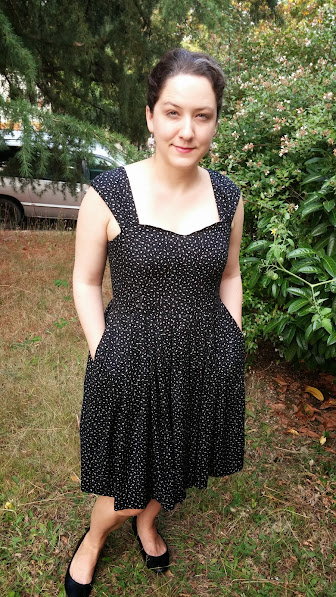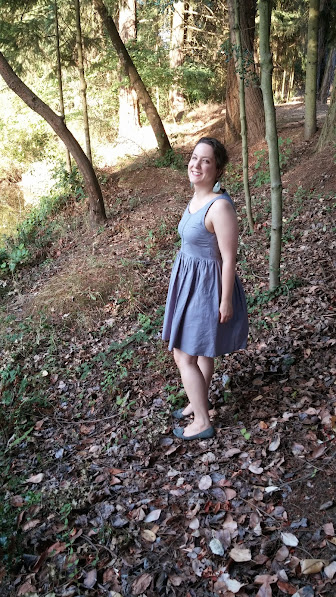More Cambie & some reflections on fitting.
Here's a better photo of the front of my Cambie #2. This time around, I pleated the skirt in, instead of gathering. That was just for fun. The main fitting change I made was to reduce the size of the sleeve. For comparison, here's Cambie #1.
I do like the way the first Cambie falls over the shoulder like a cap sleeve, but it limited my arm mobility and I didn't like the gapes and puckers on the back. I think my smaller sleeve/strap (steeve? slap? there is no good mash-up of those two words, is there?!) is a good compromise of design and functionality.
This muslin process has liberated me from some stress and negativity I've been feeling about fitting and about my body.
The liberation actually started with my OAL dress that I briefly mentioned turned out entirely different from the dress I thought it would be.
The bust darts in this dress gave me so much trouble that I actually ended up pinching them together into a faux princess seam. With this princess seam shaping, I turned the dress around from something that made my bust look like a freak-of-nature into a very well-fitted bodice. The technique is a little dodgy (mostly only on the inside) because it was worked and re-worked, stitched and unpicked, so many times. Plus, I stopped caring part way through the process and used all sorts of bobbin thread colors that made the top-stitching grey looks like subtly different colors, though it was all the same on top... thus, I started calling the whole outfit "50 Shades of Grey", which started out as a sort of derogatory epithet, but gradually grew on me. Much like the outfit itself. Mostly because it actually fits me!
So fast-forward to the Cambie muslin experience. After 50 Shades of Grey, I felt more confident that I could make a pattern work, even if I needed to change it a lot.
Here's another part of the liberation: it doesn't have to look just like the pattern illustration. For some reason, aking an indie pattern, I felt a certain pressure to produce the design as it was designed. Maybe it's because they cost more or because you can see the designers' blogs or all the other examples of how people have make the same design.
Indie patterns are no different than the patterns I hack up from the thrift store. I could make a sample of a pattern that looks just like the photo or drawing on the envelope and it could fit the abstract person from the size chart or look nice on a dress-form, but it wouldn't fit me -- thus, it wouldn't be a good dress, no matter how well it was made or how closely it matched the original design.
I also recently read Lladybird's post about Emery fitting process. My first Emery muslin left me really depressed about my body and that pattern. While everyone else was swooning about how perfectly their muslins of this pattern looked, I thought I was alone in the fact that this pattern fit me like crap the first time around and didn't respond to simple fitting fixes that I usually use. When I read about how Lauren made 6 muslins and then saw how she had the pattern perfected to use later, it was really inspiring.
We all have body challenges. Rosin of Dolly Clackett fame often talks about her "derp back", which always makes me smile because I think her back looks lovely... but I know the feeling of having a derp body part... we all have something like this that is a fitting challenge. RTW calls them problem areas... I think these derp areas are more like challenge areas for sewists... we get to really test ourselves and if we stick to it, we get perfectly-fitted bespoke clothing. What a gift we can give ourselves!
So I am not going to shy away from my derp body... I'm short and my bust/waist/hips each measure a different standard size... but I can still make things that fit and flatter me.
Thanks to the sewing bloggers out there for inspiration to get me through my fitting depression!
I do like the way the first Cambie falls over the shoulder like a cap sleeve, but it limited my arm mobility and I didn't like the gapes and puckers on the back. I think my smaller sleeve/strap (steeve? slap? there is no good mash-up of those two words, is there?!) is a good compromise of design and functionality.
This muslin process has liberated me from some stress and negativity I've been feeling about fitting and about my body.
The liberation actually started with my OAL dress that I briefly mentioned turned out entirely different from the dress I thought it would be.
The bust darts in this dress gave me so much trouble that I actually ended up pinching them together into a faux princess seam. With this princess seam shaping, I turned the dress around from something that made my bust look like a freak-of-nature into a very well-fitted bodice. The technique is a little dodgy (mostly only on the inside) because it was worked and re-worked, stitched and unpicked, so many times. Plus, I stopped caring part way through the process and used all sorts of bobbin thread colors that made the top-stitching grey looks like subtly different colors, though it was all the same on top... thus, I started calling the whole outfit "50 Shades of Grey", which started out as a sort of derogatory epithet, but gradually grew on me. Much like the outfit itself. Mostly because it actually fits me!
So fast-forward to the Cambie muslin experience. After 50 Shades of Grey, I felt more confident that I could make a pattern work, even if I needed to change it a lot.
Here's another part of the liberation: it doesn't have to look just like the pattern illustration. For some reason, aking an indie pattern, I felt a certain pressure to produce the design as it was designed. Maybe it's because they cost more or because you can see the designers' blogs or all the other examples of how people have make the same design.
Indie patterns are no different than the patterns I hack up from the thrift store. I could make a sample of a pattern that looks just like the photo or drawing on the envelope and it could fit the abstract person from the size chart or look nice on a dress-form, but it wouldn't fit me -- thus, it wouldn't be a good dress, no matter how well it was made or how closely it matched the original design.
I also recently read Lladybird's post about Emery fitting process. My first Emery muslin left me really depressed about my body and that pattern. While everyone else was swooning about how perfectly their muslins of this pattern looked, I thought I was alone in the fact that this pattern fit me like crap the first time around and didn't respond to simple fitting fixes that I usually use. When I read about how Lauren made 6 muslins and then saw how she had the pattern perfected to use later, it was really inspiring.
We all have body challenges. Rosin of Dolly Clackett fame often talks about her "derp back", which always makes me smile because I think her back looks lovely... but I know the feeling of having a derp body part... we all have something like this that is a fitting challenge. RTW calls them problem areas... I think these derp areas are more like challenge areas for sewists... we get to really test ourselves and if we stick to it, we get perfectly-fitted bespoke clothing. What a gift we can give ourselves!
So I am not going to shy away from my derp body... I'm short and my bust/waist/hips each measure a different standard size... but I can still make things that fit and flatter me.
Thanks to the sewing bloggers out there for inspiration to get me through my fitting depression!



Both of your dresses look lovely on you! :)
ReplyDeleteThanks, Carolyn! :)
ReplyDelete